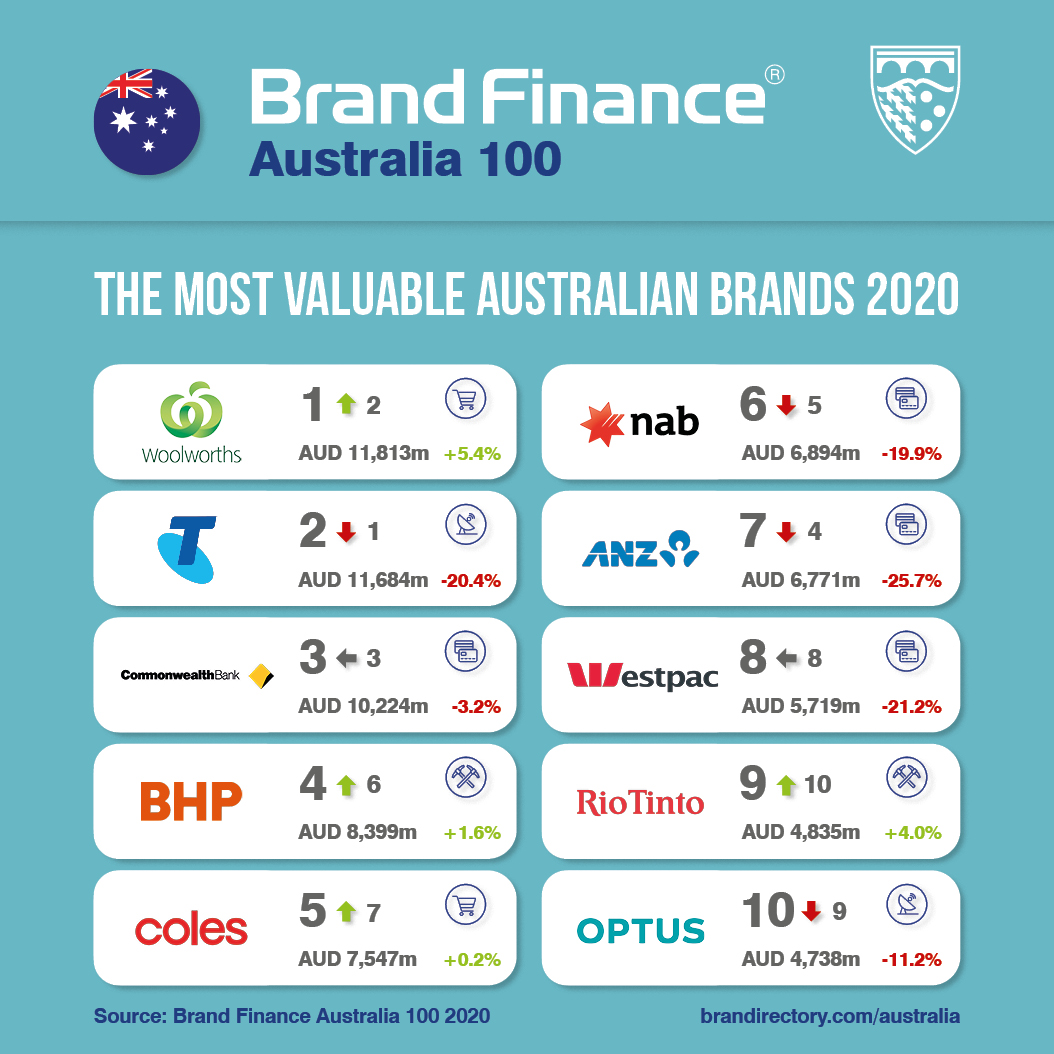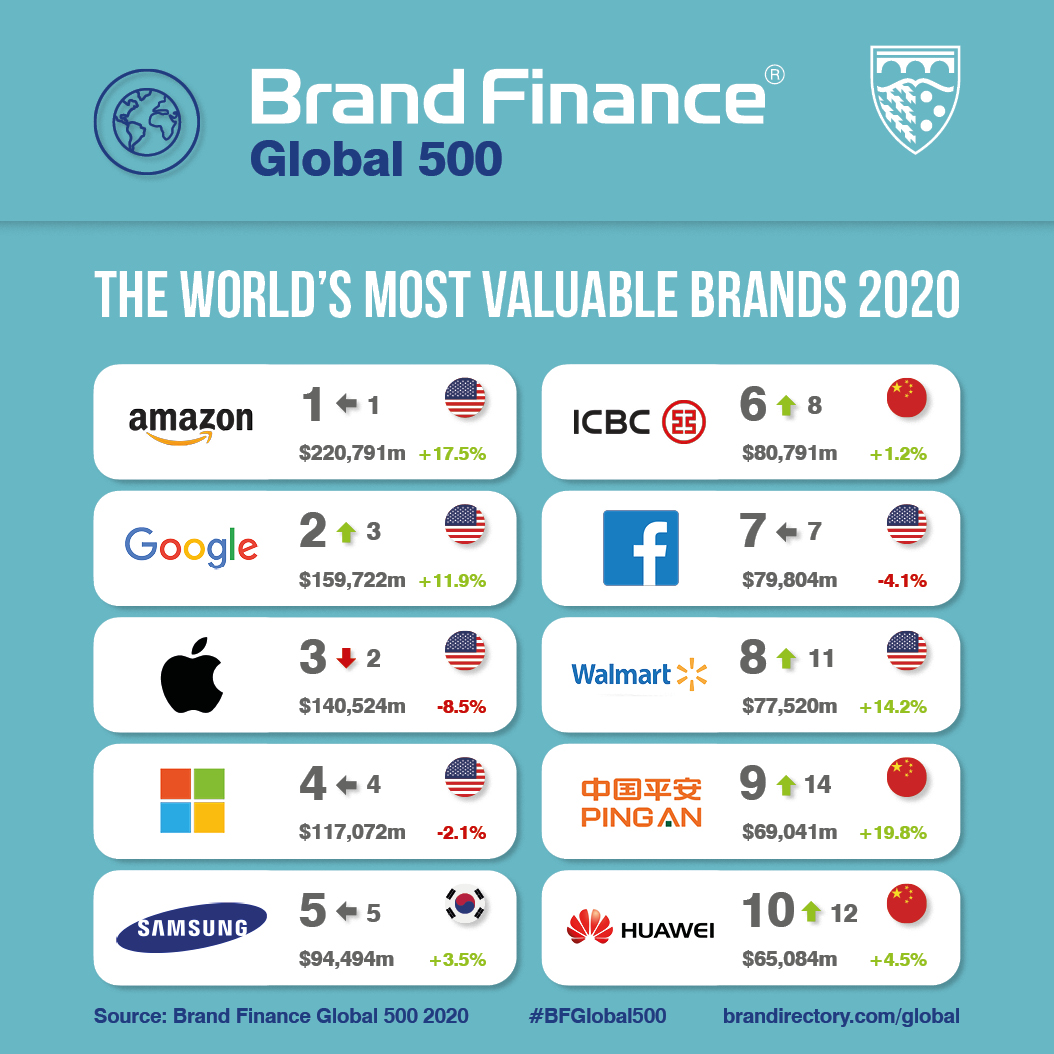Woolworths regains title of Australia’s Most Valuable Brand as Telstra falls flat – Brand Finance report

Woolworths has reclaimed the title of Australia’s most valuable brand, overtaking reigning champion Telstra, after recording a 5% uplift in brand value to AU$11.8 billion, according to the latest report by Brand Finance, the world’s leading independent brand valuation consultancy.
In addition to measuring overall brand value, Brand Finance also evaluates the relative strength of brands, based on factors such as marketing investment, familiarity, loyalty, staff satisfaction, and corporate reputation. Alongside revenue forecasts, brand strength is a crucial driver of brand value. Woolworths’ increasing brand strength, up 4.2 to a Brand Strength Index (BSI) score of 81.9, has enabled it to overcome a tough market, where retail activity is contracting, and economic growth forecasts are gloomy.
View the full Brand Finance Australia 100 2020 here
Fellow supermarket brand, Coles (brand value AU$7.5 billion), has also been feeling the pinch as shoppers are becoming increasingly careful with their spending habits. However, its small brand value increase (up 0.2%) is a very positive result following its demerger with Wesfarmers, the country’s largest ever demerger. Coles has achieved a AAA- brand strength rating for the first time, a reflection of the brand’s solid reputation for value for money.
Says Mark Crowe, managing director, Brand Finance Australia: “We are witnessing a decreasingly optimistic market, where many of the country’s biggest consumer brands are suffering. Household names, Woolworths and Coles, are bucking the trend, supported by their long-standing position in the marketplace. Woolworths is facing a difficult year ahead after the damaging investigation into staff’s pay – how the brand responds in the coming year will be pivotal if it is to retain its title of the most valuable Australian brand.”
Telstra calls for help
The country’s largest mobile network provider, Telstra, has recorded a considerable drop in brand value over the past year, down 20% to AU$11.7 billion. The NBN rollout has significantly affected the brand’s profits, which dropped 40% in 2019, and the long-term economic outlook for the brand looks challenging. Telstra is grappling with, along with the majority of key players globally, the rise in challengers in the Telco-OTT space, as well as rapidly diminishing margins as a result of fierce price competition.
Telstra’s BSI score has improved, however, up 1.9 to 84.0, largely due to a greater level of customers recommending the telecoms giant, a testament to the brand’s first-class customer service and solid customer satisfaction scores.
Says Crowe: “Despite the drop in brand value, Telstra’s brand strength index score has increased by 1.9 points to 84.0, highlighting the importance of its brand to drive long term growth. Telstra and other telecos are facing significant challenges to implement effective strategies to fend off rising competition from newer, alternative media and communications brands. The way in which we consume telecommunications has changed for good and all telecoms brands will have to adapt if they want to survive this shift in the sector.”
Optus nation’s strongest
Optus (down 11% to AU$4.7 billion) claims the title of Australia’s strongest brand with a BSI score of 86.3 out of 100 and a corresponding AAA brand strength rating. This boost in brand strength has simultaneously knocked last year’s strongest brand Qantas (down 18% to AU$3.1 billion) off the top of the podium.
Says Crowe: “Optus’ solid reputation for excellent customer service and value for money, is reflected in the one million new post‑paid customers that subscribed in the last year. Among the top 10 strongest brands, Coles and NRMA Insurance have experienced significant strengthening (over 5 BSI points increase) of their brands.”
Banking sector nosedives
Australian banks are facing turbulent times, as the delayed effects of the global economic slowdown are being felt across the country. This, paired with the sector’s public scandals and the ongoing fallout from the Royal Commission, has created a less than favourable environment, resulting in all banking brands losing brand value this year.
The country’s biggest lender, Commonwealth Bank, lost 3% of its brand value down to AU$10.2 billion, amid weak forecast revenue growth. Nevertheless, the bank’s brand strength has recovered this year, regaining its AAA brand strength rating (BSI 84.9).
ANZ suffered the second biggest monetary brand value loss in the ranking (down AU$2.3 billion to AU$6.8 billion) and the highest percentage loss in the top 20 (down 26%). The brand’s revenue has been falling consistently over the past few years, and with the high costs of customer remediation following the inquiry needing to be factored in, the bank’s position seems unlikely to change in the coming year.
Shortly after Westpac (down 21% to AU$5.7 billion) began to rebuild its reputation, following the Royal Commission scandal, the brand has been plagued with millions of breaches of anti-money laundering laws, further hindering its reputation.
Adds Crowe: “Financial institutions are certainly familiar with being scrutinised closely and with the country’s banks feeling the heat following the Royal Commission, the spotlight will be closely on them as they try to rebuild and repair their damaged reputations. Australia’s banks all face the same brand challenge in the coming year, to restore trust, customer retention and satisfaction, and ultimately to rebuild their brand value.”
Bottoms up to new entrants
There are 11 new entrants into the ranking this year, with engineering and construction brand Downer (brand value AU$1.3 billion), the highest ranked in 29th position. Downer has celebrated success through winning high value contracts nationally and internationally, through its acquisition of Repurpose it, a waste resource company, and through winning multiple awards for its sustainability efforts.
Six wine brands have entered the ranking this year, with five of these owned by Treasury Wine Estates. Following nearly a decade-long wine glut – significant oversupply of product – the sector is now entering a period of growth, largely thanks to the exports business boosting profits across the board. The highest new wine brand entrant, Lindeman’s (brand value AU$774 million), in 50th position, is enjoyed in over 100 countries globally and produces the top selling Australian wine in three countries. Last year, the brand launched its first alcohol-free range in response to the decline in alcohol consumption, particularly in the millennial age bracket.
Worley is fastest growing
Engineering and construction brand, Worley, is this year’s fastest-growing Australian brand recording an impressive 88% brand value growth to AU$584 million. Following Worley’s acquisition of Jacobs ECR in May, and its subsequent rebrand, the company’s reach has expanded considerably, entering key high growth markets, including Europe, Canada, the Middle East and India.
Mining brands climb ranks
BHP and Rio Tinto are climbing the ranks, entering the top 5 and top 10 respectively. BHP has remained Australasia’s most valuable B2B brand, recording a 2% increase in brand value to AU$8.4 billion. BHP’s brand value has relied solely on its strong revenue forecasts in the face of a brand strength decline (down 1.8 to BSI 71.0) caused by weakening corporate social responsibility scores. Fellow mining brand, Rio Tinto, has also recorded steady brand value growth, up 4% to AU$4.8 billion.
Both brands are negotiating the increasing intolerance of new mining projects, among the Australian public and internationally; a strong brand becomes increasingly important in keeping other influential stakeholders, such as regulators, on side to maintain growth and profitability. As BHP and Rio Tinto operate across borders, they are exposed to fluctuating global trade and have suffered as a result of softening demand in China, a key market.
7 Australian brands feature in Global 500
Seven Australian brands feature in the newly released Brand Finance Global 500, with Woolworths ranked the highest. Defending its position as the world’s most valuable brand for the third consecutive year, Amazon has broken the so far unattainable US$200 billion brand value mark. Following 18% growth from US$187.9 billion last year, Amazon’s brand value has now reached US$220.8 billion, over US$60 billion more than Google’s and US$80 billion more than Apple’s.
The world’s largest online marketplace, Amazon has also branched out into cloud computing, artificial intelligence, consumer electronics, digital streaming, logistics, and is looking to enter other industries. With a diverse product and service portfolio, and thanks to continued investment in fast-growing sectors and innovative technologies, Amazon is not only the leader of today, but also seems primed for tomorrow.
Nevertheless, the majority of Amazon’s revenue still comes from retail, and challenges to the growth of the company’s core operations may result in brand value stagnation in the future. In November 2019, it was announced that Nike would no longer be selling its merchandise on the platform, to develop its own direct sales channels. Amazon may have to contend with other big brands following Nike’s lead, which would undermine its reputation as the ‘Everything Store’. Another potential sticking point is the future of Amazon’s international business. From environmentalist opposition in Europe, to backlash from local retailers in India, to saturation of China’s e-commerce market by Alibaba and its subsidiaries – matching globally the status that Amazon enjoys in the US, may prove difficult.
Says David Haigh, CEO of Brand Finance: “The disrupter of the entire retail ecosystem, the brand that boasts the highest brand value ever, Amazon continues to impress across imperishable consumer truths: value, convenience, and choice. Today, Amazon’s situation seems more than comfortable, but what will the roaring twenties hold in store?”


1 Comment
An odd data set, and the title you have written is subsequently incorrect. I would be more interested to see the most valuable brands in Australia, as your title implies, as opposed to the most valuable Australian-brands. Surely we would want to compare Coles vs Aldi; etc.
Further, when they say “Reece Australia” surely they mean Reece Group (plumbing) as opposed to the name and logo they have provided, Reese Australia … curiously a UK company, despite the name.
Considering changing my screen name to grumpy client. Thoughts?